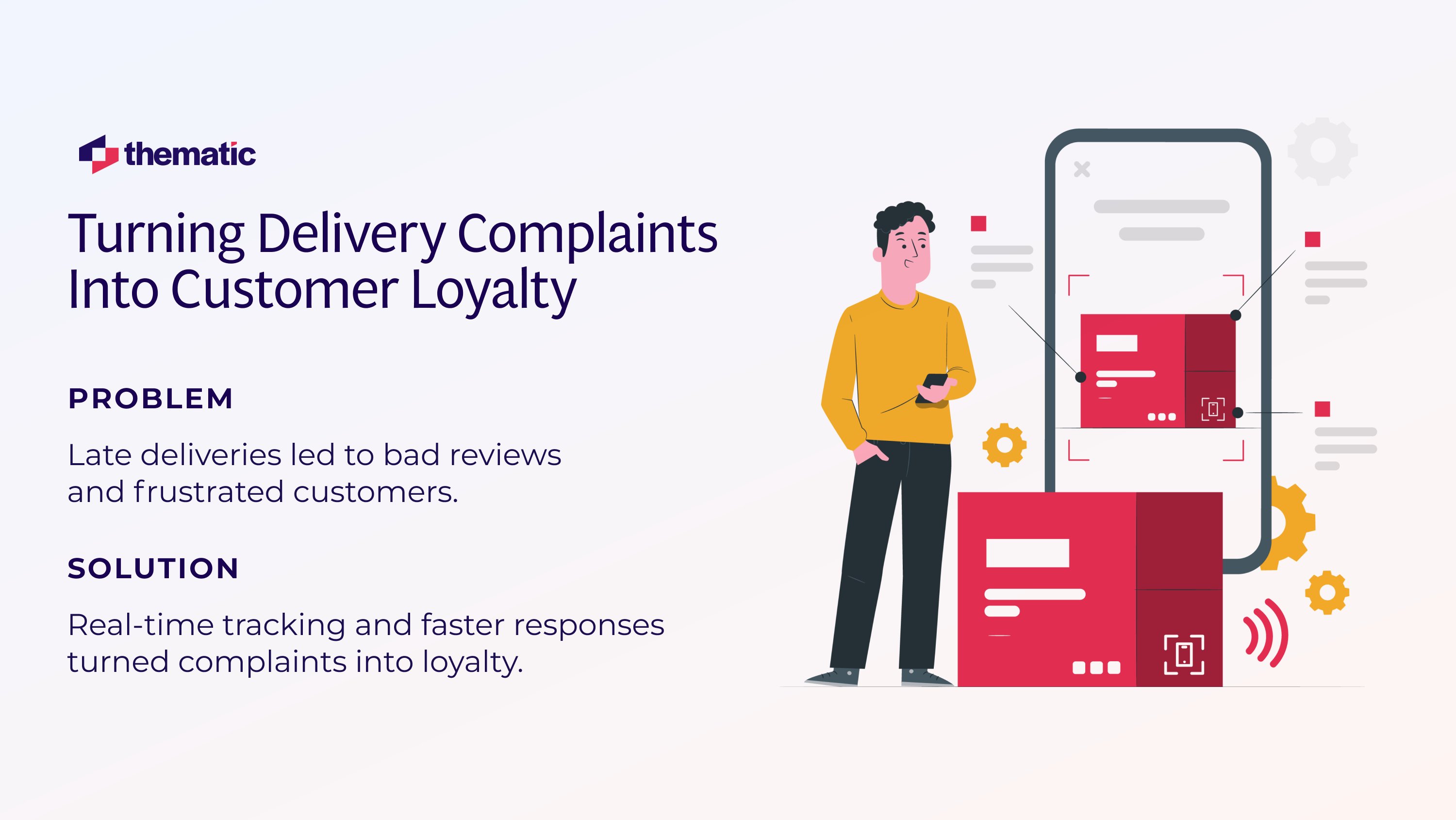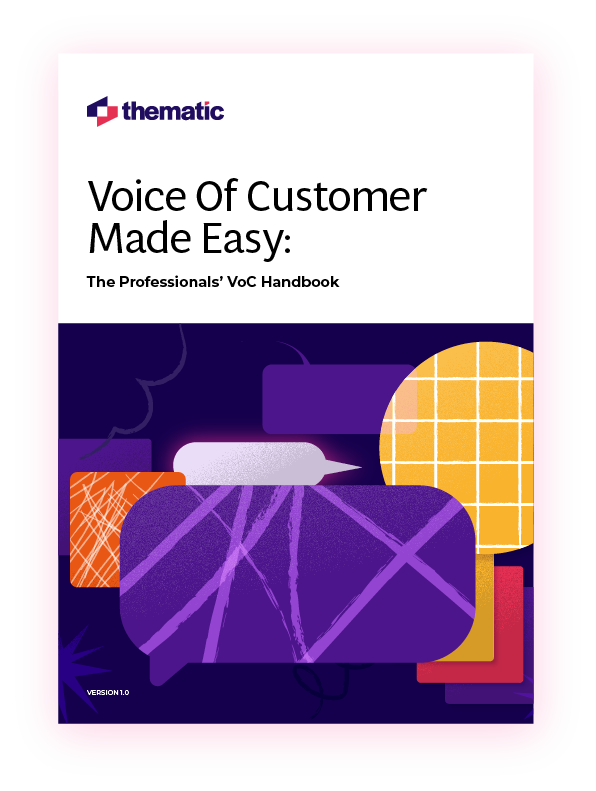
Learn how to leverage customer experience insights to enhance satisfaction, engagement, and loyalty.

What if you could anticipate your customers’ needs before they even tell you? That’s the power of customer experience insights—real-time feedback and data-driven analysis that help businesses understand what customers want, what frustrates them, and how to improve their journey.
Companies that actively apply customer insights boost retention, loyalty, and competitive advantage.
So, how do you turn insights into action? It’s all about strategy. Businesses need to collect, analyze, and apply customer feedback effectively. Here’s how:
We’ll dive into 10 customer insights strategies for better customer satisfaction. Let’s go!
Listening to your customers in real time is essential to improving satisfaction and preventing churn. Studies show that 73% of consumers will switch to a competitor after multiple bad experiences, and more than half will leave after just one. Worse, 79% of customers will switch brands if they find a competitor with a better experience.
Without an effective system for capturing and responding to feedback, businesses risk losing customers before they even have a chance to resolve their concerns.
To stay ahead of customer expectations, businesses must collect structured and unstructured feedback through:
These methods, combined with AI-powered survey tools, help businesses extract meaningful insights from open-ended responses, online reviews, and customer support interactions.
Just look at the case of DoorDash. It takes a fast and flexible approach to gathering feedback, ensuring customer insights drive key business decisions. Their lean research team uses AI-powered analytics to process thousands of net promoter score (NPS) survey responses, identifying real-time pain points.
One example? They redesigned their Merchant Menu Manager after detecting a drop in NPS scores due to frustrations with its usability. After implementing improvements, menu update times dropped from 11 seconds to under 3 seconds, significantly improving satisfaction.
By leveraging real-time Voice of Customer feedback, businesses can detect issues early, optimize customer experience, and prevent churn. The key is not just collecting data—but acting on it before customers decide to leave.
Customers today engage with businesses across multiple channels. Yet, many businesses struggle to connect the dots and gain a holistic view of their customer journey. They need conversational analytics or customer review analysis to help track, analyze, and personalize interactions seamlessly across all touchpoints.
Customers interact with businesses through various touchpoints, including:
Each of these touchpoints generates valuable feedback that businesses must track and analyze to improve customer experience. Tracking these touchpoints ensures businesses can analyze customer behavior holistically and identify friction points.
Imagine this: A leading retail brand struggled with inconsistent customer experiences between online and in-store purchases. By using AI-powered customer review analysis, they uncovered that mobile shoppers expected faster checkout options, while in-store customers wanted better product availability updates. After aligning their digital and in-store experience, they saw higher satisfaction scores and improved retention rates.
To truly optimize customer experience, brands must track and analyze interactions across all touchpoints, ensuring they deliver a clear, connected journey for every customer.
Customer emotions play a critical role in shaping their experience with a brand. Sentiment analysis, also known as opinion mining, is the process of determining whether a piece of text carries a positive, negative, or neutral emotional tone.
It is widely used for analyzing customer feedback, survey responses, and product reviews to help businesses understand how customers feel about their products, services, and overall experience.
Sentiment analysis typically follows these steps:
While traditional rule-based sentiment analysis relies on predefined word lists, AI-powered sentiment analysis enhances accuracy by:
AI-powered sentiment analysis is especially valuable for businesses managing large datasets, as it automates classification without manual intervention, ensuring faster, more reliable insights.
By integrating AI-driven sentiment analysis, companies can track emotional trends, detect dissatisfaction early, and make data-driven improvements to enhance customer experience.
Still, the best thematic analysis software enhances this process by combining AI with human oversight just like how Thematic does it. This process ensures high accuracy and a nuanced understanding of customer emotions.
Vodafone, for example, used AI-driven sentiment analysis to enhance customer satisfaction by analyzing thousands of customer interactions. By identifying recurring pain points in support interactions, they were able to implement targeted service improvements, leading to higher NPS scores and reduced churn rates.
For brands aiming to improve customer experience, leveraging sentiment analysis and thematic analysis software ensures they stay in tune with customer emotions and continuously optimize their service.
Even the best businesses have friction points that cause frustration and lead to customer churn. Identifying and addressing these pain points is key to enhancing satisfaction and retention. However, many companies lack a structured approach to uncovering these weak spots in the customer journey.
Businesses can map the customer journey using qualitative data analysis and advanced tools like:
Here’s a scenario: A SaaS company analyzed customer feedback using generative AI and found that users struggled with onboarding complexity. By implementing personalized tutorials and AI-driven customer support, they reduced drop-off rates by 30% and improved first-time user satisfaction.
To prevent frustration and customer churn, brands must actively use feedback loops, qualitative data analysis, and generative AI to continuously refine and optimize the customer journey.
Customers are constantly providing feedback, but businesses often struggle to identify patterns and predict future needs from vast amounts of unstructured data. AI and machine learning help here—they allow businesses to detect trends, forecast customer behavior, and take proactive action before small issues become major problems.
AI-powered customer insights platforms analyze feedback across multiple channels, uncovering patterns that human analysts might miss. For example:
Leading e-commerce brands use Thematic Analysis AI to identify early warning signs of churn—like negative sentiment in reviews or reduced engagement levels. By proactively offering discounts, personalized recommendations, or better support, they retain high-value customers before they leave.
To stay ahead, brands must integrate AI-powered analytics into their customer insights platform, ensuring they don’t just react to issues—but predict and prevent them.
As a recent study noted: “AI-driven predictive maintenance models have reduced downtime by up to 40% in manufacturing and achieved over 90% diagnostic precision in healthcare.” Clearly, AI can improve efficiency, accuracy, and proactive decision-making across industries.

AI-powered software to transform qualitative data into powerful insights that drive decision making.
Customers no longer want generic interactions—they expect brands to anticipate their needs and personalize their experiences. Businesses that successfully tailor their offerings see higher engagement, improved loyalty, and increased revenue. In fact, customer-obsessed organizations report 51% better customer retention than those that are not.
Picture this: A leading travel company used Thematic Analysis AI to analyze customer feedback and booking patterns. By integrating AI-driven insights, they developed tailored travel recommendations based on past searches and preferences. This resulted in a significant increase in repeat bookings and improved customer satisfaction scores.
To improve customer experience with thematic analysis, businesses must go beyond basic segmentation. By leveraging AI and behavioral data, they can create meaningful, customized experiences that keep customers engaged—and coming back for more.

Social media has become a powerful tool for customers to voice their experiences—whether good or bad. Brands that actively listen and engage with these conversations can identify emerging trends, prevent PR crises, and enhance customer experience. However, only 51% of businesses currently use social listening to inform their strategy.
Using social listening tools, brands can track conversations, identify sentiment trends, and respond proactively. By analyzing customer experience statistics from social media and online reviews, businesses can spot recurring issues before they escalate.
Imagine this: A major fashion retailer noticed a surge in negative comments about delayed deliveries. Instead of ignoring the backlash, they implemented real-time tracking updates and enhanced their response times. By acknowledging customer frustration and taking swift action, they transformed detractors into loyal advocates.
Businesses that engage, acknowledge, and adapt based on online reviews will see improved reputation, increased trust, and better customer loyalty.

Providing a seamless and personalized customer experience is no longer optional—it’s essential for business success. This is where Customer Experience Management (CXM) tools come into play. These platforms help businesses track interactions, automate responses, and analyze feedback to enhance customer engagement at scale.
CXM tools use AI-driven insights, real-time analytics, and automated workflows to optimize customer interactions. Features to look for include:
Here’s a case in point: A leading telecom company used text analytics tools to identify common pain points in customer interactions. By integrating CXM automation, they personalized customer engagement, reduced response times, and successfully lowered churn rates by 30%.Investing in CXM tools and AI-driven text analytics tools ensures that no feedback goes unnoticed—helping brands deliver exceptional, data-driven customer experiences.

More than being the responsibility of support teams, customer experience requires alignment across all departments, from product development to marketing and operations. When cross-functional teams have access to real-time customer insights, businesses can proactively address pain points, improve engagement, and drive innovation.
To truly benefit from customer insights, companies must:
For example, a leading SaaS company used customer feedback analytics to identify onboarding friction and missing product features. By integrating Voice of Customers for Product Operations, they revamped their onboarding flow and introduced key product enhancements—leading to higher retention rates and improved customer satisfaction.
By leveraging AI and cross-functional collaboration, companies can turn insights into action—driving better products, services, and experiences.

Understanding what customers want before they ask for it is the next frontier of customer experience. Predictive analytics, powered by AI and machine learning, helps businesses analyze historical data to forecast churn risk, product preferences, and service needs—allowing companies to act proactively rather than reactively.
Predictive analytics helps companies:
Here’s an example: A leading subscription service analyzed usage trends and engagement patterns to identify subscribers at risk of canceling. By offering personalized discounts and targeted content, they reduced churn by 22% and increased renewals.
Predictive analytics empowers brands to make data-driven decisions, helping them anticipate customer expectations, prevent churn, and drive long-term loyalty.
Delivering exceptional customer experiences isn’t just about collecting feedback—it’s about analyzing it effectively and acting on it. Businesses that prioritize customer experience insights see higher satisfaction, reduced churn, and stronger loyalty. By leveraging AI-powered analytics, companies can detect pain points, personalize interactions, and anticipate customer needs before they arise.
From real-time feedback collection and sentiment analysis to predictive analytics and AI-driven personalization, the strategies in this article show how brands can turn insights into action. Those that fail to adapt risk falling behind, while those that embrace customer experience insights and AI-powered tools gain a competitive edge.
Written by a CX expert, this handbook simplifies VoC strategies and helps you get the most from customer feedback.
What's inside:

Want to see customer insights in action? Try Thematic on your own data and discover how AI-driven analytics can help you understand, optimize, and enhance your customer experience.
Small businesses can start by using free or low-cost survey tools, analyzing online reviews, and leveraging social media listening. Many AI-powered customer insights platforms offer scalable options that grow with the business. Focusing on feedback loops and simple text analytics tools can provide actionable insights without heavy investment.
Customer experience covers the entire journey a customer has with a brand, from first interaction to post-purchase support. Customer service, on the other hand, is just one part of CX—it refers specifically to support and assistance given to customers when they need help. A great CX strategy ensures that customers rarely need to reach out for support because their journey is already optimized.
Companies can track and calculate the ROI of CX and measure CX uccess through key performance indicators (KPIs) such as customer retention rates, net promoter score (NPS), customer satisfaction (CSAT), and revenue growth. Businesses that invest in AI-driven customer insights often see lower churn rates, higher engagement, and increased sales conversions—all measurable outcomes that impact the bottom line.
Businesses must comply with data protection regulations like GDPR and CCPA, ensuring transparency in how customer data is collected, stored, and used. Using anonymized data for analysis, secure storage practices, and clear opt-in policies helps maintain trust. Partnering with AI-driven insights platforms that prioritize ethical data usage ensures compliance and customer confidence.
Join the newsletter to receive the latest updates in your inbox.